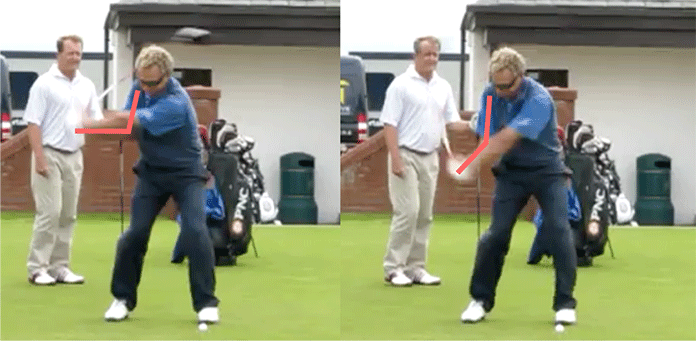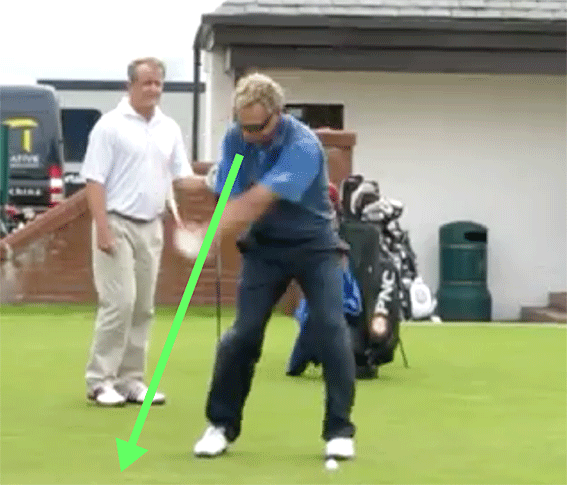Bobby Clampett's Aiming Point
“In his book “The Impact Zone”, Bobby Clampett says the Aiming Point is four inches in front of the ball (target side). In your Aiming Point chapter you suggest it’s behind the ball. Why the difference?”
Let’s look at what Mr Clampett says in his book: “To aid us in achieving a forward swing bottom on your chipping strokes, you employ the aiming point technique. Simply put, the aiming point technique refers to how the mind, at the top of the backstroke, actively directs the hands to a point in front of the ball along the ball-to-target line (also called the straight plane line, which is the Fifth Dynamic). In order to move the bottom of your swing arc and the centre of your divot forward of the ball, you have to aim your hands forward of the ball before starting your downswing as this will insure that you strike your chip shot solidly before the club head reaches the low point of the swing.”(1)
I disagree with Mr Clampett’s definition of the Aiming Point here. In The Golfing Machine glossary it is simply described as: “A point at which Thrust is directed.”(2) Not “A point in front of the ball the hands are directed.” Mr Clampett isn’t describing the true Aiming Point in the above quote, he’s discussing impact alignments. The primary alignment being the Flat Left Wrist, which, when held through impact, causes the hands to be in front of the clubhead, and in most set ups, the ball. The concept of ensuring proper impact alignments is discussed at length in The Golfing Machine; namely in 3-F-5 “The Address Routine” and 7-8 “The Fix”. The Aiming Point doesn’t provide a “forward swing bottom” or “directs the hands to a point in front of the ball” - it’s simply where you are extending the right arm, providing thrust, and initiating the Release on the downswing.
In the chapter after the above quote is a photo of Mr Clampett mid-swing with a line drawn from his eyes down to the ground a few inches in front of the ball with the following caption: “Look at the tilt of my head and where my eyes appear to be looking. That’s right, they are directed at the aiming point, not at the ball.”(3)
What Mr Clampett is looking at is actually the Low Point.(4) Which, as the name suggests, is the lowest point on the clubhead’s path.
Later in the book Mr Clampett discusses hitting down with the driver. He writes about advice he gave to Vijay Singh on how to do this: “I then introduced him to the aiming point technique, which he had never heard of, and I explained how to execute it in the exact same way as I have taught it to you, the reader, in this book. He promised he would go and practice it, then later admitted that it helped him. It had to, because moving the aiming point forward brought his swing bottom forward.”(5)
Now we can understand Mr Clampett’s confusion. From his diagrams and what he’s written it’s safe to assume Mr Clampett believes the Aiming Point should be the Low Point. He advocates directing the hands and clubhead to the Low Point and calls this the aiming point technique. This is not the Aiming Point as described in The Golfing Machine.
This can be quickly disputed by reading my chapter on the Aiming Point but also a quick flick through The Golfing Machine itself. In 6-E-2 Mr Kelley discusses how the Aiming Point isn’t a static point on the ground like the Low Point, but its location moves around depending on different factors: “...an Aiming Point can be pin-pointed by experiment and experience only, because “normal” Handspeed differs among players. Increased Handspeed and/or Sweep Release moves it aft of its “normal” Handspeed location and decreased Handspeed and/or Trigger Delay moves it forward.” and “If you “Choke Down” on longer clubs you move their Aiming Point forward. “Choke Down” to make all Clubshafts the same length means the same Aiming Point for all your Clubs.”
As for having the Aiming Point forward of the ball, towards the target, that would be next to useless for full swings. That would imply the release doesn’t take place until the hands are pretty much at impact. An Aiming Point forward of the ball is only useful for very short strokes, such as chipping. Mr Kelley, when describing the Aiming Point says this: “The Aiming Point replaces the ball so you no longer direct the #3 Pressure Point at the Ball but at the Aiming Point just as if it were the Ball - like an explosion shot from sand.”(6) And how do you play “explosion shots from the sand”? You aim behind the ball, just as your Aiming Point should be behind the ball also.
Finally let’s look at Bobby Clampett’s swing and see where his actual Aiming Point is.
I disagree with Mr Clampett’s definition of the Aiming Point here. In The Golfing Machine glossary it is simply described as: “A point at which Thrust is directed.”(2) Not “A point in front of the ball the hands are directed.” Mr Clampett isn’t describing the true Aiming Point in the above quote, he’s discussing impact alignments. The primary alignment being the Flat Left Wrist, which, when held through impact, causes the hands to be in front of the clubhead, and in most set ups, the ball. The concept of ensuring proper impact alignments is discussed at length in The Golfing Machine; namely in 3-F-5 “The Address Routine” and 7-8 “The Fix”. The Aiming Point doesn’t provide a “forward swing bottom” or “directs the hands to a point in front of the ball” - it’s simply where you are extending the right arm, providing thrust, and initiating the Release on the downswing.
In the chapter after the above quote is a photo of Mr Clampett mid-swing with a line drawn from his eyes down to the ground a few inches in front of the ball with the following caption: “Look at the tilt of my head and where my eyes appear to be looking. That’s right, they are directed at the aiming point, not at the ball.”(3)
What Mr Clampett is looking at is actually the Low Point.(4) Which, as the name suggests, is the lowest point on the clubhead’s path.
Later in the book Mr Clampett discusses hitting down with the driver. He writes about advice he gave to Vijay Singh on how to do this: “I then introduced him to the aiming point technique, which he had never heard of, and I explained how to execute it in the exact same way as I have taught it to you, the reader, in this book. He promised he would go and practice it, then later admitted that it helped him. It had to, because moving the aiming point forward brought his swing bottom forward.”(5)
Now we can understand Mr Clampett’s confusion. From his diagrams and what he’s written it’s safe to assume Mr Clampett believes the Aiming Point should be the Low Point. He advocates directing the hands and clubhead to the Low Point and calls this the aiming point technique. This is not the Aiming Point as described in The Golfing Machine.
This can be quickly disputed by reading my chapter on the Aiming Point but also a quick flick through The Golfing Machine itself. In 6-E-2 Mr Kelley discusses how the Aiming Point isn’t a static point on the ground like the Low Point, but its location moves around depending on different factors: “...an Aiming Point can be pin-pointed by experiment and experience only, because “normal” Handspeed differs among players. Increased Handspeed and/or Sweep Release moves it aft of its “normal” Handspeed location and decreased Handspeed and/or Trigger Delay moves it forward.” and “If you “Choke Down” on longer clubs you move their Aiming Point forward. “Choke Down” to make all Clubshafts the same length means the same Aiming Point for all your Clubs.”
As for having the Aiming Point forward of the ball, towards the target, that would be next to useless for full swings. That would imply the release doesn’t take place until the hands are pretty much at impact. An Aiming Point forward of the ball is only useful for very short strokes, such as chipping. Mr Kelley, when describing the Aiming Point says this: “The Aiming Point replaces the ball so you no longer direct the #3 Pressure Point at the Ball but at the Aiming Point just as if it were the Ball - like an explosion shot from sand.”(6) And how do you play “explosion shots from the sand”? You aim behind the ball, just as your Aiming Point should be behind the ball also.
Finally let’s look at Bobby Clampett’s swing and see where his actual Aiming Point is.
The video quality isn’t too great but we’re able to see on the downswing Mr Clampett’s right arm extending. As you'll know from reading my Aiming Point chapter, right arm extension is what starts the release and the direction of this extension is the Aiming Point.

It’s hard on the video to work out where exactly Mr Clampett’s Aiming Point is but it’s safe to say it’s around the area the green line points to below. You may think that’s far behind the ball but remember, Mr Clampett is a touring professional so his hand speed will be relatively high moving the Aiming Point back. He’s also swinging a driver, which, because of its length also moves the Aiming Point back.

He also appears to have taken his own advice and is looking at his Aiming Point, albeit the real one!
